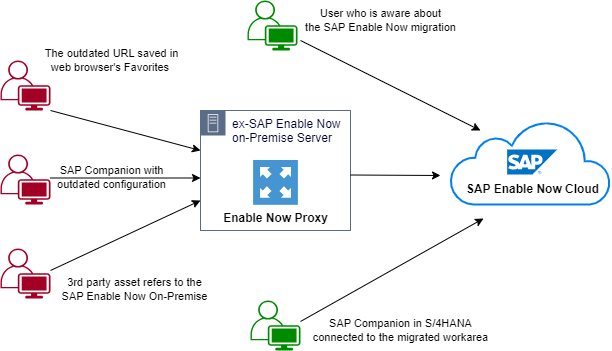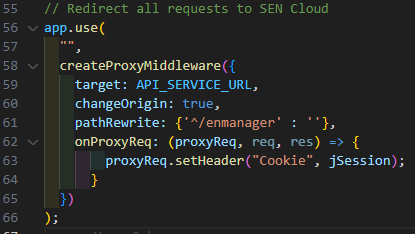
- SAP Community
- Products and Technology
- Human Capital Management
- HCM Blogs by SAP
- SAP Enable Now On-Premise -> Cloud: Keeping Links ...
Human Capital Management Blogs by SAP
Get insider info on HCM solutions for core HR and payroll, time and attendance, talent management, employee experience management, and more in this SAP blog.
Turn on suggestions
Auto-suggest helps you quickly narrow down your search results by suggesting possible matches as you type.
Showing results for
Product and Topic Expert
Options
- Subscribe to RSS Feed
- Mark as New
- Mark as Read
- Bookmark
- Subscribe
- Printer Friendly Page
- Report Inappropriate Content
09-14-2023
2:25 AM
One of my customers recently migrated their SAP Enable Now On-Premise system to the Cloud. The migration went well; all the legacy on-premise content changed its residence to the Cloud, and the Single Sign-On was re-configured with SAML 2.0. However, a delicate issue has occurred. It turned out that a large amount of 3rd party content outside of SAP Enable Now (i.e. on the intranet portal, in various LMS assets) referenced the legacy On-Premise SAP Enable Now server. If the customer shuts down the on-premise Enable Now Manager, all references will stop working. Instead of the nice-looking SAP Enable Now tutorial, one will see the nasty HTTP 404 error. Of course, the first solution which comes to one's mind is to update all the references to make them point to the Cloud system, but what if:
In this delicate situation, you might find helpful the following solution:

- No one knows exactly how many references exist
- No one knows where these attempts to reach the legacy content could come from
- Everybody is busy doing business-critical tasks
- You need to make all the legacy links work right now or, better, since yesterday.
In this delicate situation, you might find helpful the following solution:
- On the machine where the legacy SAP Enable Now On-premise system was running, we'll spin up a lightweight proxy server to forward all the requests to the Cloud SAP Enable Now.
- The customer can shut down the Apache Tomcat and SAP HANA database used for the SAP Enable Now On-premise to conclude the termination of the SAP Enable Now On-premise licenses.
- The proxy server will give the customer enough time to update the references in the 3rd party content, i.e. when the update is required.

Requirements
- The same virtual/physical server which was used for the SAP Enable Now On-Premise
- NodeJS installed
- The SSL certificate and the private key used for establishing an HTTPS connection to the legacy SAP Enable Now On-Premise (Optional when the HTTPS connection wasn't used)
- The proxy server source code from my GitHub repository
Setup
- Create the local account in your SAP Enable Now Cloud system, which we'll use as a service account to pass through the authentication. Obviously, the password should be pretty complex. The default Learners role should be enough to consume the published versions. Also, check whether the Learners or the root are included in the workareas' permissions.
- Locate the .env file in the proxy source code and enter the required values: your SAP Enable Now Cloud URL, the "service account" credentials

- If your legacy SAP Enable Now server utilized the secure HTTPS connection, upload the SSL certificate with the private key to the certificate folder of the proxy server and update the paths on lines 18 and 19 in the index.js file.

- Update the path to your legacy SAP Enable Now Manager on line 61 in the index.js file. Example: if my legacy SAP Enable Now Manager had the URL like this: https://i-love-on-premise.com/enmanager/, then the value in the pathRewrite object on line 61 will look like this

- Set the same HTTP or/and HTTPS port as your legacy SAP Enable Now Manager had on lines 13 (HTTP) and 74 (HTTPS).


- If the legacy SAP Enable Now on-Premise Manager only had the HTTP connection, comment out line 74.
- Adjust the SAP Enable Now user session update interval on line 44. The value is in milliseconds. In the below screenshot, it's set to 30 minutes. It must be less than the Validity Time of Session(s) value set in your SAP Enable Now Cloud Manager (Administration - Server Settings - General - Cahes and Timeouts)

- Start the proxy server by executing npm start
That's all folks!
Labels:
You must be a registered user to add a comment. If you've already registered, sign in. Otherwise, register and sign in.
Labels in this area
-
1H 2023 Product Release
3 -
2H 2023 Product Release
3 -
Business Trends
104 -
Business Trends
4 -
Cross-Products
13 -
Event Information
75 -
Event Information
9 -
Events
5 -
Expert Insights
26 -
Expert Insights
19 -
Feature Highlights
16 -
Hot Topics
20 -
Innovation Alert
8 -
Leadership Insights
4 -
Life at SAP
67 -
Life at SAP
1 -
Product Advisory
5 -
Product Updates
499 -
Product Updates
40 -
Release
6 -
Technology Updates
408 -
Technology Updates
10
Related Content
- Does ‘GROW or RISE with SAP’ include Localization for HCM? in Human Capital Management Blogs by SAP
- SAP Mentor Spotlight Interview: Chris Paine in Human Capital Management Blogs by SAP
- How to avoid latency in the Compensation Module in Human Capital Management Blogs by SAP
- Propagating Original Start Date to Rehire with new employment. in Human Capital Management Blogs by SAP
Top kudoed authors
| User | Count |
|---|---|
| 13 | |
| 3 | |
| 3 | |
| 2 | |
| 2 | |
| 2 | |
| 2 | |
| 2 | |
| 2 | |
| 1 |